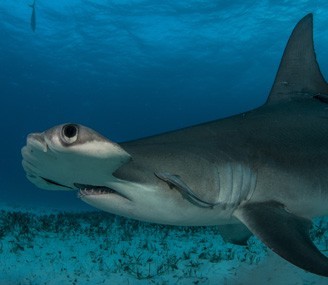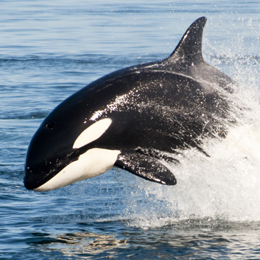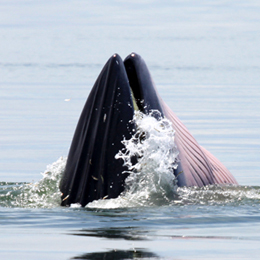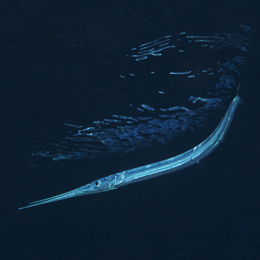Introduction and Physical Characteristics
The Great Hammerhead Shark gets its name due to its massive size and a hammer-shaped head which is called the cephalofoil. There are over 400 different species of sharks and over 8 species of hammerheads have been recognized so far. The great hammerhead is the largest of all. It can be easily distinguished from other hammerhead species by the structure of its cephalofoil. They have a wide cephalofoil with a straight and smooth front edge while in other species this hammer is not as smooth and may have a curved front margin.
Great hammerheads have a set of well-evolved fins that allow the massive fish to navigate swiftly in the ocean waters. The long sickle-shaped dorsal fin and a pair of large pectoral fins provide stability in water while the elongated tail fin acts as a propeller, capable of pushing the great hammerhead at speeds of up to 40 km/h. Great hammerheads have a relatively large second dorsal fin and anal fins. The pelvic fin is also easily identifiable due to its concave rear margin. Like most sharks, female great hammerheads tend to grow larger than males. Though they are capable to reach a length of up to 6 meters or 20 feet, on average, an adult great hammerhead shark is only 3.5 to 4 meters. The weight ranges between 200 to 500 kg. The heaviest great hammerhead ever recorded weighed up to a massive 580 Kg.
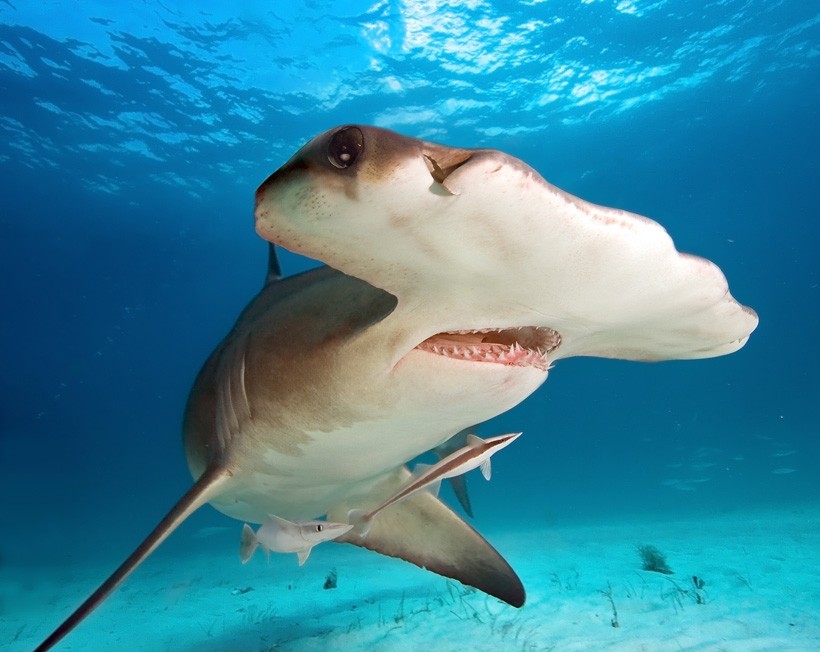
The Great Hammerhead is the largest of all hammerhead species on the planet.
?
Image credits: frantisekhojdysz/Shutterstock
Like all sharks, the great hammerhead is a master of senses. It uses over seven sensory systems to understand and survive the ocean waters. The sense of vision is very fine-tuned; each eye is located at the end of its hammer-shaped cephalofoil, allowing the shark a wide angle vision of its surroundings. The sense of hearing also proves to be extremely essential, as sound travels faster in water than in air. Great hammerheads can hear its potential prey from a distance of over 250 meter. Similarly, a shark’s sense of smell is very acute. Like terrestrial predators, hammerhead sharks are known to follow the scent of blood in order to scavenge in the ocean waters.
Apart from these sensory systems, great hammerheads have two additional super senses although little is known about its functions. One of them are the lateral lines run along both sides of the shark’s body, extending up to the tip of its tail. These lines can detect very minute vibrations and movements in the water allowing the shark to locate its potential prey precisely, even in complete darkness. The other super sense is electroreception. Every creature generates an electric field around itself and the tiny pores on the cephalofoil of a great hammerhead shark can detect such minute electric signals. This sensory system is quite essential for locating well-camouflaged or ground-dwelling potential prey.
Simply, the great hammerhead is built to be an apex predator. Even when it cannot see, smell, hear or feel anything, it can locate potential prey by simply following the electric field. When the potential prey is spotted, the immense strength, speed and the sharp teeth get the job done quite efficiently.
Habitat, Distribution and Lifestyle
The great hammerheads inhabit tropical ocean waters. They can be found living in continental shelves and inshore waters with depths of less than 1 meter. Being a migratory species, they can also survive in offshore waters with a depth of up to 80 meter. The great hammerhead’s range typically spreads across the globe. They can be observed in ocean waters anywhere between of latitudes of 40 N and 37 S. In the Pacific Ocean, great hammerheads are found from Southern California and Baja California to Peru and from Ryukyu Islands, Japan, China to Australia in the South. The species is found dwelling in continental shelves throughout the Indian Ocean. In the Atlantic Ocean it occurs from Senegal to Morocco and the Mediterranean Sea in the east, to Uruguay till North Carolina, in the west including the Caribbean Sea and the Gulf of Mexico.
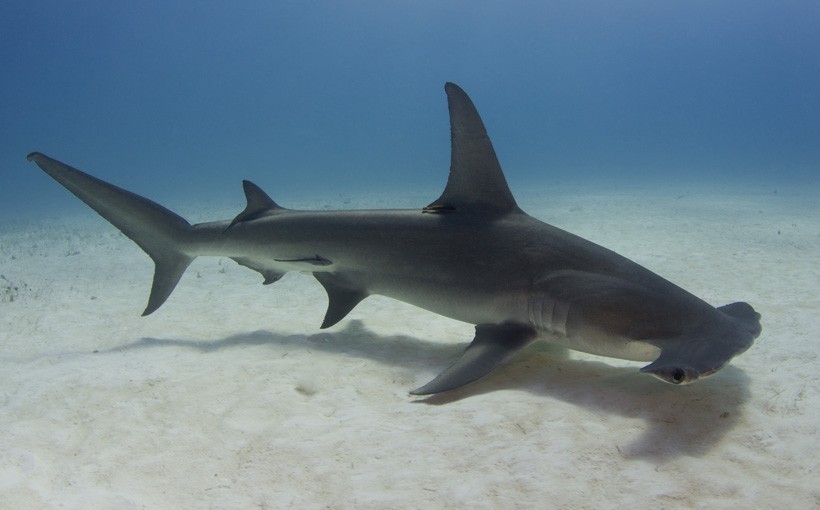
Great Hammerhead, Bimini, Bahamas
?
Image credits: Matt9122/Shutterstock
Great Hammerhead sharks are known to migrate but little is known about their migratory patterns. It is suspected that great hammerheads move closer to the poles in search of cooler water and better availability of potential prey during summer. Bridging large travelling distances, the great hammerhead swims on one of its sides. This swimming method is called rolled swimming, where the shark rolls to its side and continues swimming forward. This posture reduces drag and conserves energy while the large dorsal fin is used to obtain lift. Great hammerheads may use the rolled swimming method very often in order to keep their energy consumption rate under control. Captive great hammerheads have been observed using this method for up to 90 % of its time.
This wide range of distribution provides a variety of potential prey for the Great Hammerheads. The most preferred prey is the sting ray but they consume also crabs, squids, octopus and small bony fishes like sardines, catfish, croakers and box fish. Great hammerheads are highly opportunistic animals and when an opportunity presents itself, they would simply go for the kill. Hammerheads have been spotted feeding on smaller sharks and other hammerheads as well.
Great hammerheads, like other sharks, use a fatal first bite to immobilize the prey before finally feeding on it. However, the adapted cephalofoil allows the great hammerhead to attain better control over the body of its prey. Hammerheads use the hammer as a pivot to pin the potential prey to the bottom, directing it straight to the shark’s deadly jaws.
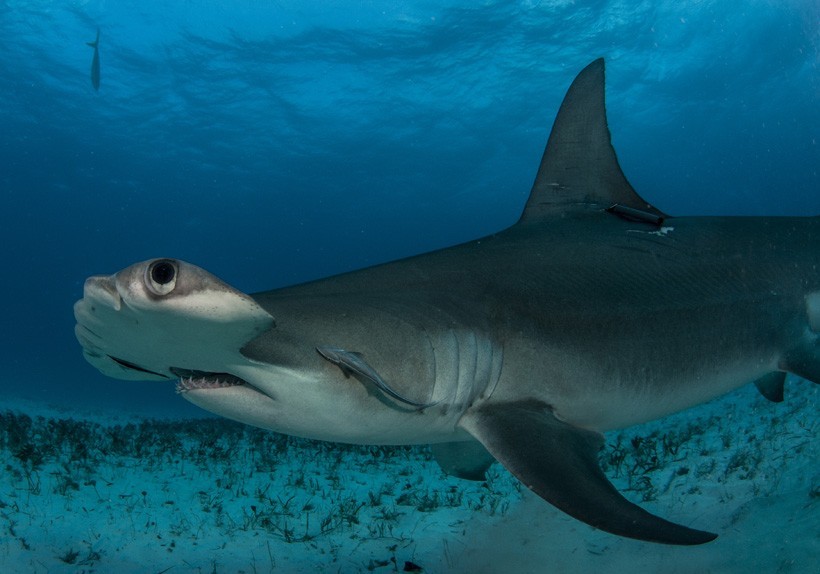
Great Hammerhead, Bimini in the Bahamas
?
Image credits: Shane Gross/Shutterstock
Hammerheads have up to 17 sharp serrated teeth rows on either side of its upper and lower jaw. These triangular-shaped teeth are sharp enough to remove chunks of meat on every bite, making the great hammerhead one of the most feared species of sharks on the planet. However, great hammerheads are not the fiercest as they often get killed by other, larger sharks like the great whites and tiger sharks. These sharks can be over 25 feet in length and their jaws and bite-strength are larger than that of the Great Hammerhead.
Hence, despite being an apex predator, the great hammerheads have to keep a safe distance from larger sharks in order to survive in its habitat.
Reproduction and Life Cycle
Great hammerheads are viviparous, which means that the female gives birth to live pups. Females mate only once every two years. When receptive, a male uses his claspers, which are actually evolved pelvic fins, to transfer his sperm into the female. Mating behavior can be termed as aggressive as the male often bites the female until she admits for mating. Unlike other sharks, hammerheads have been frequently spotted mating close to the surface of the water. After copulation, the female undergoes a gestation period of 11 months and gives then birth to up to 10 to 40 pups in one litter.
Pups grow inside a yolk-like structure inside the mother which later on transforms into a mammalian placenta-like structure when the yolk is fully consumed by the pups. The pups receive nutrition through the placenta for another few months. After birth, the mother does not provide sustenance anymore.
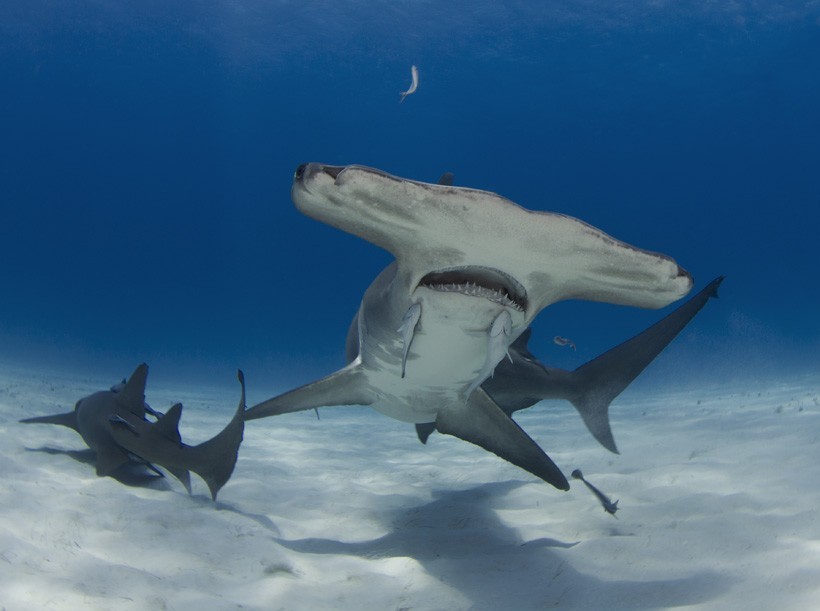
Great hammerhead shark swimming in shallow sea
?
Image credits: Matt9122/Shutterstock
At birth, the pups are only 50 to 60 cm in length and have a rounded frontal margin on the cephalofoil. As the pups have to fend for themselves, they face numerous threats in the ocean. Sharks, birds of prey and other large fish actively hunt on hammerhead pups for an easy meal. An additional major threat for pups is fishing.
Great hammerheads may reach sexual maturity anywhere between 8 to 10 years. In fact, sexual maturity in great hammerheads depends more on the size and weight of an individual. At 2.3 to 2.8 meter the male pups become sexually mature, while the females mature when being 2.5 to 3 meter. At sexual maturity, males are mostly 50 kg in weight and females close to 40 kg. With a lifespan of just 20 to 30 years in the wild, a female great hammerhead reproduces only 10 to 15 times in its lifetime.
Apparently, all these factors result in a very low survival rate for the great hammerhead sharks.
Behavior and Intelligence
Great hammerheads are solitary predators. However, they have been spotted also in large groups during migration periods in summer. Mostly nocturnal, these sharks can also actively hunt during the day. They do not use vocalizations, but great hammerheads do conduct a minimal level of communication through body language. Body movements like an open mouth, tail flapping and swimming patterns are used to convey simple messages like aggression, depression and submission.
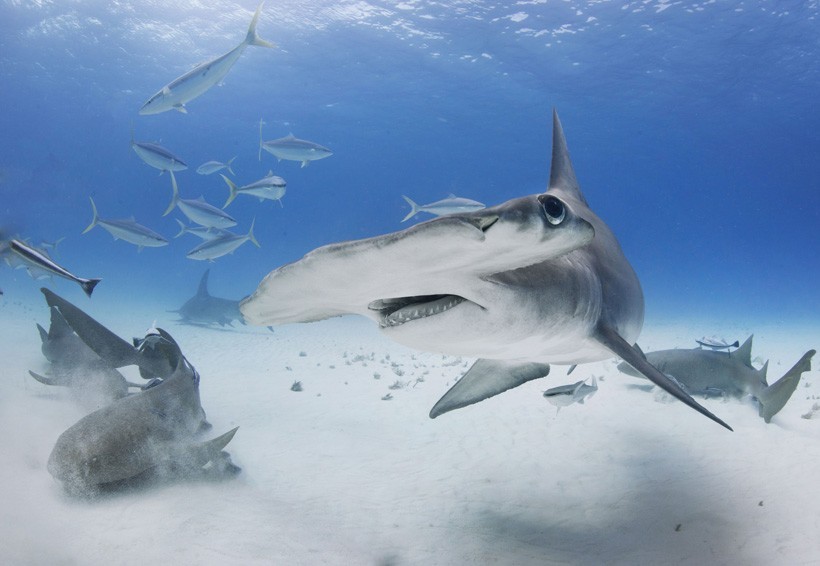
Great Hammerhead turns with fins down
?
Image credits: Liquid Productions, LLC/Shutterstock
Despite, great hammerheads are highly intelligent predators. Their behavior cannot be judged easily, which regularly results in attacks on humans. Generally shy, the great hammerhead shark does get highly offensive when provoked. Unprovoked attacks are not fatal as it results only from the curiosity of the shark. Sharks in their natural habitat may use objects for biting in order to determine whether it is consumable or not. Such a bite can inflict painful wounds when such object concerns a human body.
Though great hammerhead shark attacks are rather rare, they are feared as killers of the sea. Hundreds of rumors exist but the fact is that out of 34 attacks recorded by the International shark attack file, none have been proved to be fatal. It is also possible that out of these reported 34 attacks, only a few or even none actually may have been caused by the great hammerhead species.
Cultural Predictions
Great hammerheads are globally endangered and the major factor behind the observed population decline is overfishing.
Shark fin soup is a popular delicacy in many countries and to address the demands, sharks are killed in large numbers globally. A kilogram of shark fins cost approximately 85 to 120 dollars and the large hammerhead fins prove to be more lucrative.
Just like other sharks, hammerhead sharks are apex aquatic predators and their extinction can result into catastrophic consequences in nature. But among humans, the value of this important creature seems to be cheaper than a hundred dollar bill.
Population and conservation
Great hammerhead sharks are an endangered species and hunting or harming them is considered illegal in many countries. These sharks have a very long generation time as a female reproduces only once in every two years. Due to this, the great hammerheads were already limited in number and when the human demand for shark fins arose rapidly, this number dropped at a drastic rate.
Fishing on an industrial scale is the prime factor behind the endangered status of this species. As humans implemented modern methods of large-scale fishing, fishes with limited abundance, like the great hammerheads, became highly vulnerable. Researchers estimate that there has been a drop of up to 50 % in the great hammerhead population over the last three decades. Though many nations are working to conserve the species, the hammerhead population is still on a steady decline.
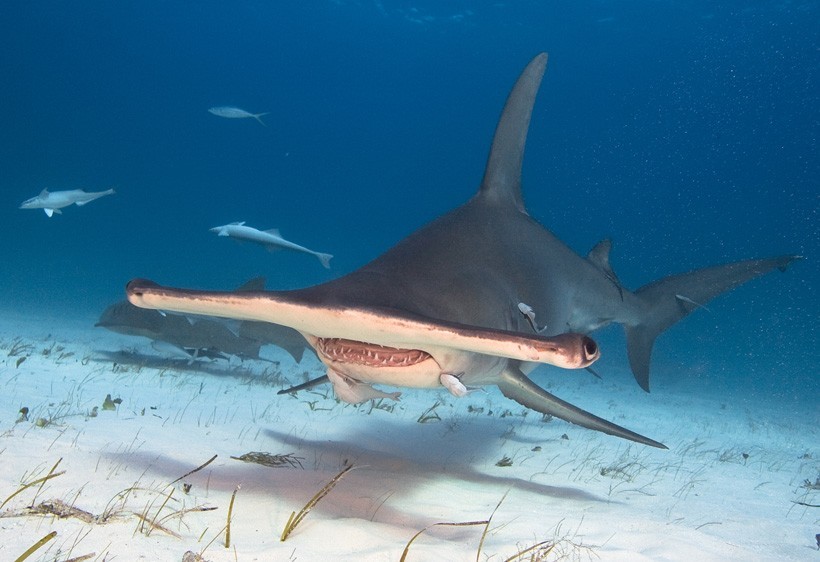
Great hammerheads reproduce only once every two years.
?
Image credits: frantisekhojdysz/Shutterstock
Great hammerheads are migratory, which means they can travel to international waters where government rules cannot be controlled that efficiently. Illegal traders use these international waters to hunt for hammerheads and other endangered and rare creatures of the oceans. The popularity of shark fin soup in Asian countries is a prime factor behind the population decline of the great hammerheads. As the IUCN classifies the species as endangered, several countries have now banned shark finning and there is a remarkable rise in public awareness about the importance of great hammerheads and other endangered shark species. However, the future of the great hammerhead population continues to be quite uncertain.
Evolution
The great hammerhead is considered to be the youngest shark species on earth. According to fossil records, the earliest sharks evolved somewhere between 450 to 425 million years ago. During this period, thousands of different species of sharks evolved on earth. According to the theory of natural selection, the species with better adaptations survived and flourished over the others. According to paleontologists, sharks have survived all 5 mass extinctions on earth.
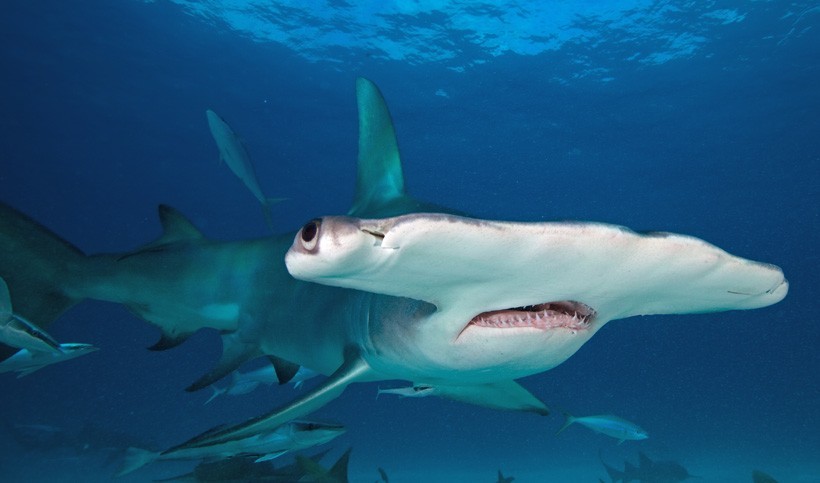
Great hammerhead closeup head
?
Image credits: Martin P, Sphyrna mokarran/Shutterstock
Early sharks had fixed jaws and smooth skin. Approximately 210 million years ago, 12 new groups of sharks evolved. It was during this period when the flexible upper jaw and dermal denticles began to appear in sharks. This adaptation proved to be highly effective and enable the sharks to rule the ocean waters. During times of mass extinctions, sharks somehow survived by adapting for surviving in deeper waters.
Great whites and the large megalodons evolved approximately 20 million years ago. The wide head of the great hammerhead also indicates that it is one of the most recently evolved species of shark. The first hammerhead teeth discovered by paleontologists were only 50 to 35 million years old. As sharks don’t have bones but cartilages, fossils of their skeletal structure are rarely found. Most of the evolution theory is derived from fossilized teeth unearthed by scientists. Though teeth provide a remarkable amount of information, determining precise information about the ancestry of a species with just teeth is quite difficult.
Funfacts
- Great hammerheads are the largest of all hammerhead species. They can be up to 20 feet in length and a thousand pounds in weight.
- Great hammerheads reproduce only once every two years.
- The regular litter size is in between 10 to 40. Rarely great hammerheads may give birth to up to 55 pups.
- Sting ray is evidently the favorite prey of the great hammerhead. They are immune to their sting.
- Great hammerheads can be distinguished from other hammerheads by its cephalofoil, which has a very straight frontal margin.
- Great hammerheads have super senses like electroreception and vibration-sensing lateral lines while the wide placement of eyes provides the shark an optimal vision angle.
- To conserve energy great hammerheads swim on their side. This habit is called rolled swimming, which is generally used while travelling large distances in the open ocean.
- The Great hammerhead is the most recently evolved species of shark.
- Over the last 30 years the population of great hammerhead sharks has declined by 50 %.
- Due to shy nature and migratory habits of the great hammerheads the conservation efforts are quite ineffective and the population continues its decline.
